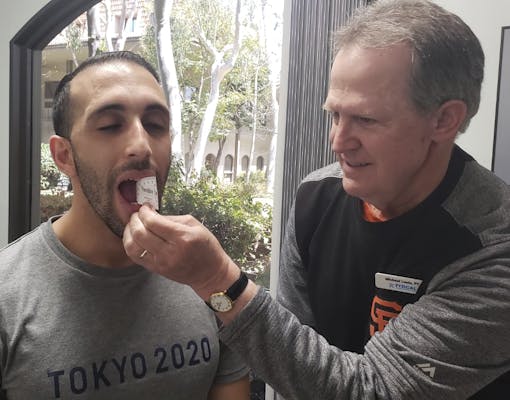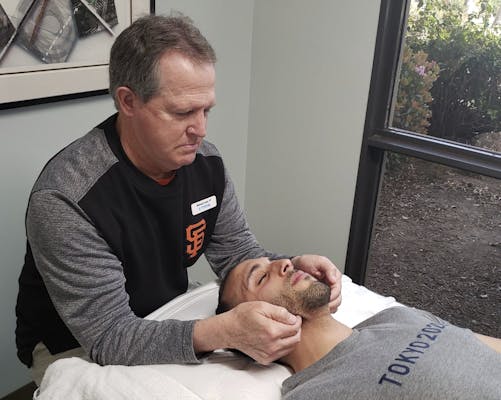Temporomandibular joint disorder, or dysfunction, (TMD) is a common condition that limits the natural functions of the jaw, such as opening the mouth and chewing. Over the years, Atlantis Physical and Occupational Therapy has developed long-term relationships with the region’s dentists and oral maxillofacial surgeons who have come to rely on our customized programs to relieve pain and improve range of motion for their patients suffering from this condition.
TMD currently affects more than 10 million people in the United States. It is sometimes incorrectly referred to as simply “TMJ,” which represents the name of the joint itself. TMD affects more women than men and is most often diagnosed in individuals aged 20 to 40 years. Its causes range from poor posture, chronic jaw clenching, and poor teeth alignment, to fracture or conditions such as lockjaw, where the muscles around the jaw spasm and reduce the opening of the mouth. Physical therapists help people with TMD ease pain, regain normal jaw movement, and lessen daily stress on the jaw.
What Is Temporomandibular Joint Disorder?
Temporomandibular joint disorder (TMD) is a common condition that limits the natural function of the jaw, such as opening the mouth and chewing, and can cause pain. The temporomandibular joint (TMJ) is a hinge joint that connects your jaw to your skull in front of your ear. The TMJ guides jaw movement and allows you to open and close your mouth and move it from side to side to talk, yawn, or chew.
TMD can be caused by:
- Bad posture habits
- Chronic jaw clenching ("bruxism")
- Problems with teeth alignment ("malocclusion")
- Fracture
- Surgery
- Trismus ("lockjaw")
- Displacement of the disc or soft-tissue cushion located between the ball and socket of the TMJ, which causes popping or clicking of the jaw and, frequently, pain.
- Arthritis in the TMJ
How Does It Feel?
The symptoms of TMD can be temporary or last for years. Jaw pain is the most common symptom.
CAUTION: Jaw pain also can be a symptom of heart attack. Seek medical care immediately if jaw pain is accompanied by:
- Chest pain
- Shortness of breath
- Dizziness
- Left arm pain
- Numbness in the left arm
- Nausea
TMD can cause the jaw to lock or get stuck in a certain position. You may experience headaches, feel pain when chewing certain foods, or have difficulty fully opening your mouth.
TMD symptoms include:
- Jaw pain
- Jaw fatigue
- Difficulty opening your mouth to eat or talk
- Ringing in your ears
- Dizziness
- Headache
- Popping sounds in your jaw
- Neck pain
- Locking jaw
A Comprehensive Treatment Approach
Your physical therapist can help you restore the natural movement of your jaw and decrease your pain. Based on your condition, your therapist will select treatments that will work best for you.
Your treatments may include:
- Posture Education. If you sit with your head in an increased forward position, you are placing greater strain on the muscles beneath your chin, causing the lower jaw to pull back and the mouth to be in an open position even when resting, increasing stress on the TMJ. You also might be overworking the jaw muscles to force the jaw closed so your mouth isn't open all the time. Your physical therapist will teach you to be aware of your posture so that you can improve the resting position of your jaw, head, neck, breastbone, and shoulder blades when you're sitting and walking.
- Improving Jaw Movement. Physical therapists use skilled hands-on techniques (manual therapy) to gently increase movement and relieve pain in tissues and joints. Your physical therapist may use manual therapy to stretch the jaw in order to restore normal joint and muscle flexibility or break up scar tissues ("adhesions") that sometimes develop when there is constant injury.
Your physical therapist will teach you special "low-load" exercises that don't exert a lot of pressure on your TMJ, but can strengthen the muscles of the jaw and restore a more natural, pain-free motion.
- Special Pain Treatments. If your pain is severe, your physical therapist may provide treatments, such as electrical stimulation or ultrasound to reduce it.
- Cranial Sacral Therapy (CST) is a hands-on technique that focuses on your head (cranium), spine, and sacrum (a triangular bone at the base of the spine). Using light pressure, a therapist releases tension in the connective tissue and encourages the flow of fluid between the cranium, spine, and sacrum. CST is practiced by a variety of health-care professionals, including massage therapists, physiotherapists, and dental professionals.
This gentle technique is ideal for treating TMD as it allows therapists to access the hard-to-access muscles surrounding the jaw and TMJ, and offers a safe and effective way for a therapist to manually move the joint in order to improve flexibility and range of motion. CST can also reduce stress, which may contribute to TMJ difficulties. Read more about CST by clicking here.
- Referral to a Dentist. If your TMD is caused by teeth alignment problems, your physical therapist can refer you to a dentist who specializes in TMD, who can correct the alignment with special appliances, such as "bite guards" that create a natural resting position to relax the TMJ, relieve pain, and improve jaw function.


